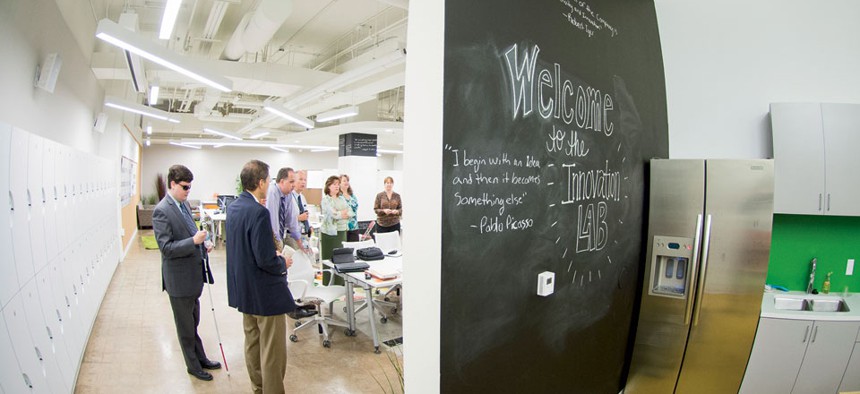
James Kegley
Making Room for Big Ideas
No matter its size or mission, every agency needs an innovation lab for thinking outside the box.
More than five years ago, then-candidate Barack Obama vowed to “make government cool again.” Since then, he has advocated vocally for technology and innovation, inspiring advancements that have reduced waste and delivered services more effectively. The Federal Emergency Management Agency, for example, digitized disaster recovery, enabling some 304,000 survivors of Hurricane Sandy to register for assistance through mobile apps. The outcome? Better, faster results at a lower cost.
But there is only so much President Obama and his administration can do to advance innovation using a top-down approach. The recent increase in government innovation labs represents a dedication by agency leadership to an important procedural and cultural shift. Establishing a lab in every agency, large and small, would give all employees a safe place to think and act outside the bureaucratic box, test disruptive ideas, elicit expertise from across and outside of government and innovate from the ground up.
Several models of innovation labs exist across corporate, academic and governmental organizations, but they generally consist of a dedicated space and procedural framework to develop and test creative solutions. The methodologies used in innovation labs rely on design principles, which can also be applied to policies, processes, services and experiences.
In 2012, the Office of Personnel Management transformed a 3,000-square-foot basement into an innovation lab, with inspiration from design experts at IDEO and the Luma Institute. The space is now used to solve problems within OPM and human resource issues across government. OPM is also developing a training curriculum to educate employees about human-centered design and the potential for a more citizen-centric government.
I worked for the Homeland Security Department from 2010 to 2012, and I learned about the uphill battles federal agencies face when they attempt something radically new. I saw examples of innovation being driven by senior leaders, but for most employees it was nearly impossible to get things done quickly, creatively or collaboratively.
As an intern at the Labor Department last summer, I explored whether the department shared DHS’ barriers to innovation. Working for Xavier Hughes, Labor’s chief innovation officer, I supported efforts to innovate through mobile app development, civic hacking events and engagement with private sector experts. The department even participated in the National Day of Civic Hacking and brought in developers to help it connect with women veterans. Labor has leadership that proactively leads standalone efforts to innovate, but the agency still lacks a culture of change. To really bring Labor, DHS and the rest of the federal government into the 21st century, agencies need to disrupt the way they do business.
There’s no one-size-fits-all model. Every agency should identify its unique challenges and culture, study best practices, continually measure impact and make course corrections along the way. Without these advancements, the government will continue to lag behind other sectors. Innovation labs may be the ticket by which agencies can generate new ideas, execute them in an organic way and bring about meaningful change from the inside out.
Amelia Mann is an Ash Center Summer Fellow, a 2015 master’s in public policy candidate at the Harvard Kennedy School, and a 2015 MBA candidate at the Tuck School of Business at Dartmouth.
NEXT STORY: Fighting The Future Enemy







